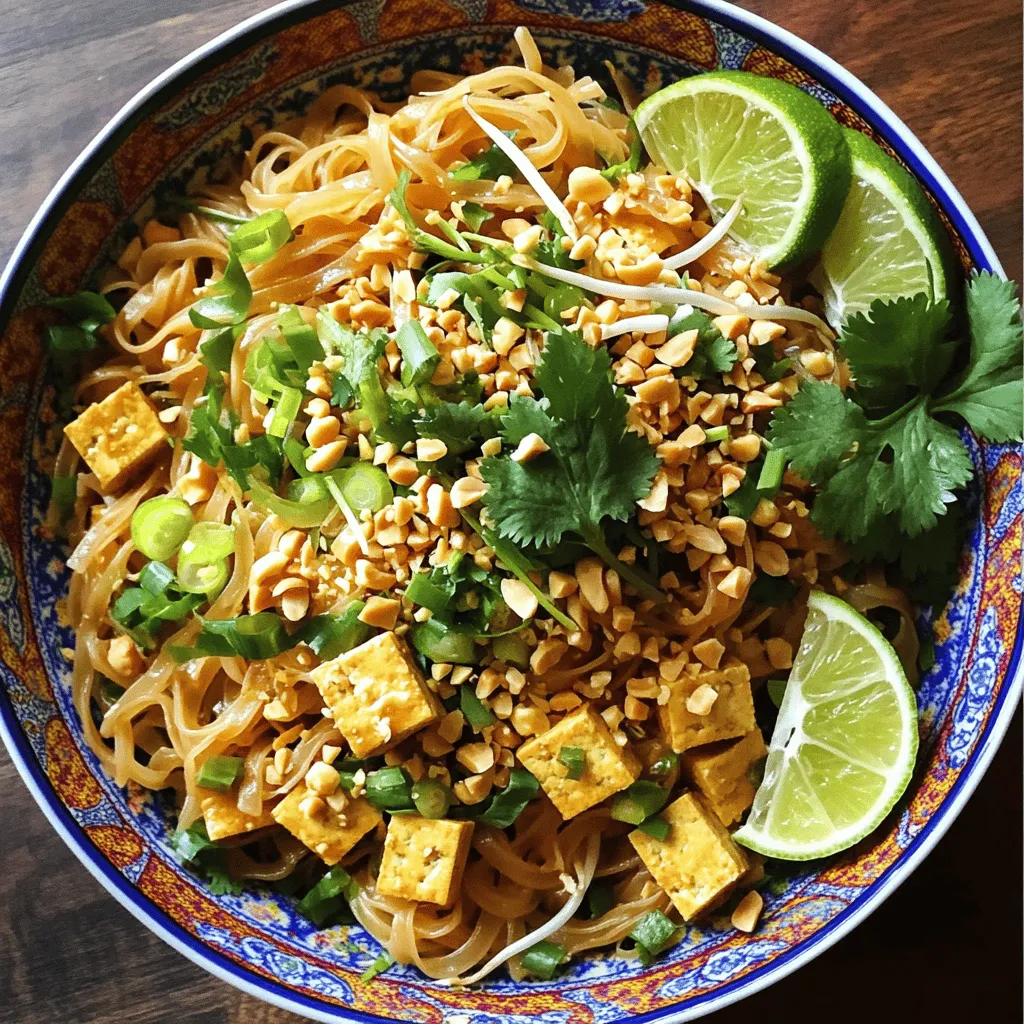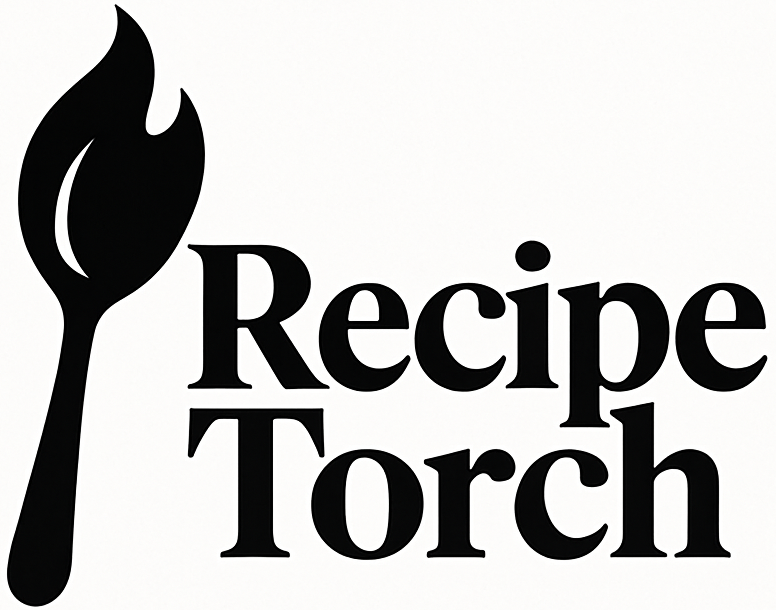Are you craving a delicious meal that’s easy to make at home? This Easy Pad Thai recipe is your answer! I’ll guide you step-by-step to whip up this classic dish that bursts with flavor. From choosing fresh ingredients to mastering the perfect noodle texture, you’ll learn handy tips and tricks to make this meal a family favorite. Let’s dive into the simple process of creating your own Pad Thai at home!
Ingredients
Complete List of Ingredients
Main Ingredients for Easy Pad Thai
– 8 ounces rice noodles
– 2 tablespoons vegetable oil
– 2 cloves garlic, finely minced
– 1 cup firm tofu, cubed (substitute with chicken if preferred)
– 2 large eggs, lightly beaten
– 1 cup fresh bean sprouts
– 3 green onions, chopped (reserve half for garnish)
– ¼ cup crushed peanuts, plus extra for garnish
– 3 tablespoons soy sauce
– 2 tablespoons packed brown sugar
– 1 tablespoon freshly squeezed lime juice
– Fresh cilantro leaves, for garnish
– Lime wedges, for serving
When you gather these ingredients, think about the flavors. Rice noodles give a nice base. Tofu adds a soft texture, while garlic brings a punch. The crunchy peanuts and fresh bean sprouts add fun bites.
Optional Ingredients and Substitutions
You can mix it up! Try shrimp or chicken instead of tofu. For a vegetarian twist, use tempeh. Lime juice is key, but you can also add tamarind for a tangy kick.
Tips for Freshness and Quality
Always pick fresh vegetables. Look for firm tofu and avoid any that feel slimy. Use fresh lime for juice. It tastes better than bottled juice. When you have fresh ingredients, your Pad Thai will shine!Enjoy cooking!
Step-by-Step Instructions
Preparation Steps
1. Soaking the Rice Noodles
Start by placing 8 ounces of rice noodles in a large bowl. Cover them with hot water. Let them soak for about 10 minutes or until they are soft but still have a slight bite. This step is key for perfect noodles. After soaking, drain them and set them aside. Make sure they do not stick together.
2. Sautéing the Aromatics and Cooking the Protein
In a large skillet or wok, add 2 tablespoons of vegetable oil. Heat it over medium-high heat. Once hot, add 2 cloves of minced garlic and sauté for about 30 seconds. This will fill your kitchen with a lovely aroma. Next, add 1 cup of cubed tofu or chicken. Cook until golden brown on all sides, about 3-4 minutes. Stir occasionally for even cooking.
3. Combining All Ingredients Mindfully
Push the cooked protein to one side of the skillet. Pour in 2 beaten eggs on the other side. Stir gently to scramble them until fully cooked. Mix them with the tofu or chicken. Now, add the soaked rice noodles to the skillet. Toss everything together with tongs or chopsticks. Pour in a mixture of 3 tablespoons of soy sauce, 2 tablespoons of brown sugar, and 1 tablespoon of lime juice. Stir well to coat all ingredients evenly. Finally, add 1 cup of fresh bean sprouts and half of the chopped green onions. Toss again and cook for an additional 2-3 minutes until everything is hot.
These steps will help you create a delicious and colorful Easy Pad Thai.
Tips & Tricks
Cooking Techniques
Achieving the Perfect Noodle Texture
To get great noodles, soak them in hot water. Follow the package directions. They should be soft yet firm, not mushy. After soaking, drain them well. If they stick together, rinse them briefly under cool water.
How to Scramble Eggs Like a Pro
For perfect scrambled eggs, push your cooked tofu aside in the pan. Pour the beaten eggs right into the empty space. Stir gently and keep an eye on them. They should be golden and fluffy, not dry.
Using Tongs vs. Chopsticks for Tossing
Tongs are great for tossing noodles. They give you more control. If you prefer chopsticks, use them for a fun touch. Both tools work; choose what feels best for you.
Flavoring Tips
Adjusting the Sauce to Your Taste
Taste your sauce before adding it to the noodles. If you want it sweeter, add more brown sugar. For extra tang, squeeze in more lime juice. Don’t be afraid to play with flavors!
Best Practices for Adding Fresh Vegetables
Add fresh vegetables like bean sprouts at the end. This keeps their crunch. Toss them in the pan for just a few minutes. You want them warm but still crisp.
Balancing Sweetness and Tanginess
Sweetness and tanginess make your dish shine. If your Pad Thai is too sweet, add more lime juice. If it’s too tangy, sprinkle in more sugar. Finding the right balance is key to a great dish!

Variations
Protein Alternatives
Tofu vs. Chicken: Which Is Best?
Tofu is great for a meatless meal. It soaks up flavors well. Chicken gives a tasty, savory bite. Both options work nicely in Easy Pad Thai. Choose based on your taste and diet.
Adding Shrimp or Other Seafood
Shrimp adds a lovely sweetness to Pad Thai. Simply sauté shrimp until they turn pink. You can also use other seafood like scallops or squid. These choices bring a fresh ocean flavor to the dish.
Vegetarian or Vegan Modifications
For a vegan dish, stick with tofu. You can use vegetable broth instead of chicken broth for the sauce. Replace eggs with scrambled tofu or chickpea flour. This keeps the meal rich and hearty.
Flavor Profiles
Spicy Pad Thai Adjustments
Want some heat? Add chili flakes or sriracha to the sauce. Start with a little, then taste. You can always add more if you like it spicy. This adjustment makes your Pad Thai exciting and bold.
Adding Unique Ingredients (like bell peppers, carrots)
Try adding bell peppers for crunch and color. Shredded carrots also add a sweet touch. You can toss in other veggies like snow peas or broccoli. These additions make your dish more colorful and nutritious.
Southwest Style Pad Thai Options
For a fun twist, think Southwest! Swap soy sauce for a chipotle sauce. Add black beans and corn for a hearty mix. Top it with avocado and fresh cilantro. This gives your Pad Thai a fresh and unique flavor.
Storage Info
Refrigeration Tips
To keep your Easy Pad Thai fresh, store leftovers in an airtight container. This helps to lock in flavors and moisture. Make sure the dish has cooled down before sealing it. Easy Pad Thai lasts for about 3 to 4 days in the fridge. If it smells off or looks strange, it’s best to toss it out.
Reheating Instructions
When it comes to reheating, using the stovetop is often better than the microwave. The stovetop helps maintain the texture of the noodles. To reheat on the stovetop, add a splash of water or oil in a pan. Heat over medium until warm. If using a microwave, place the Pad Thai in a bowl and cover it. Heat in short bursts, stirring in between.
To prevent your noodles from getting sticky, add a little water or oil before reheating. This keeps them nice and moist. If they feel too dry, toss in a bit more sauce or fresh lime juice to brighten the flavors. Enjoy your delicious Pad Thai, even the next day!
FAQs
Common Questions About Easy Pad Thai
Can I Make Pad Thai Without Tamarind Paste?
Yes, you can skip tamarind paste. Use lime juice instead. It offers a nice tang. You can also use vinegar if you don’t have lime.
What Are the Best Noodles for Pad Thai?
Rice noodles are best for Pad Thai. Look for flat rice noodles, often called rice sticks. They cook quickly and soak up flavors well.
How to Make Pad Thai Gluten-Free?
To make Pad Thai gluten-free, use gluten-free soy sauce. Also, check the rice noodles for gluten-free labels. Most rice noodles are naturally gluten-free.
Troubleshooting Tips
What to Do If My Noodles Are Too Sticky?
If your noodles are sticky, rinse them under cold water. This will help separate them. You can also add a bit of oil when cooking them.
How to Enhance Flavor if Dish Seems Too Bland?
Add more soy sauce or lime juice for a flavor boost. You can also sprinkle in some crushed peanuts or chili flakes to spice things up.
Overcooked Ingredients: What Can I Do?
If you overcook vegetables, try adding fresh ones at the end. Fresh bean sprouts or green onions can add crunch and color.
Additional Inquiries
Can I Make Pad Thai Ahead of Time?
Yes, you can prepare Pad Thai ahead of time. Just store the cooked noodles and sauce separately. Combine them right before serving for best results.
Ways to Serve Easy Pad Thai for Gatherings
For gatherings, serve Pad Thai in large bowls. Offer lime wedges and extra peanuts on the side. This lets everyone customize their dish.It gives details on calories, protein, and more for a balanced meal.
In this guide, I covered the key ingredients and steps to make Easy Pad Thai. You learned how to select fresh ingredients, cook the noodles perfectly, and enhance flavors. Variations offer options for different diets, like vegetarian and gluten-free. Storing and reheating tips will help keep your dish fresh. Remember, the right balance of flavors and techniques will elevate your Pad Thai experience. Enjoy making this dish; it’s a fun way to impress family and friends!


